St. John has some of the best beaches in the US Virgin Islands and the entire Caribbean. Spectacular beaches like Trunk Bay Beach, Maho Beach, Cinnamon Bay Beach, Hansen Bay Beach, and Honeymoon Beach have some of the best powdery white sand and crystal-clear turquoise waters in the Caribbean. Many stunning beaches have lush vegetation surrounding the shoreline. Relaxing on a beach on St. John on a vacation or cruise day gives you the feeling of being in a tropical paradise.
St. John (USVI) is a popular cruise destination and vacation hotspot in the eastern Caribbean. The best beaches in St. John offer diverse experiences, from stunning snorkeling spots with vibrant coral reefs and colorful marine life to secluded coves providing the perfect vacation getaway. Some of the most isolated beaches are only accessible by hiking or boat.
St. John has over 30 stunning beaches in small bays around its shoreline. The best beaches are on the northern shore, and the two most popular are Trunk Bay Beach and Maho Beach. Cruz Bay Beach is close to the ferry terminal and is popular with cruise passengers.
Are you looking to explore some of the best beaches in St. John? In this article, I’ve reviewed the top 29 beaches in St. John—from the most popular ones to some lesser-known gems that are worth discovering.
Please read on to learn about St. John beaches and start planning your dream vacation or cruise day today.
Introducing St. John, USVI
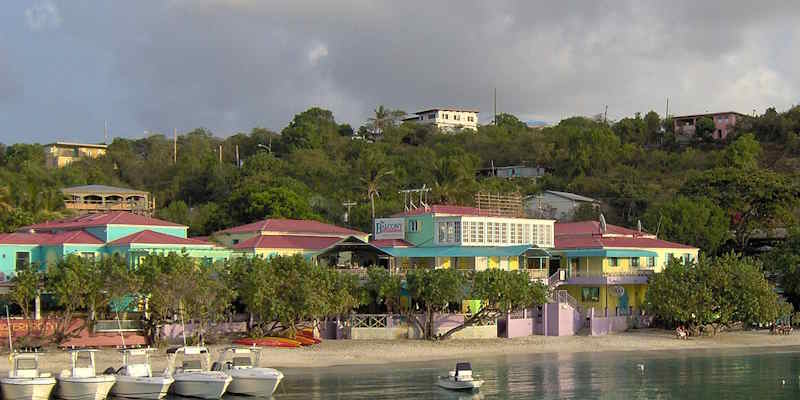
St. John is a picturesque island paradise located in the US Virgin Islands. It’s the smallest of the USVI, located four miles (6.4 km) east of St. Thomas. The small, picturesque island is known for stunning beaches, crystal clear waters, and vibrant marine life. All tourists arrive by boat, usually at Cruz Bay.
St. John is a popular destination for Caribbean cruise passengers who spend a cruise day in St. Thomas. The appeal of St. John is its pristine natural beauty. Two-thirds of the island is a protected zone in Virgin Islands National Park. Around the coast, you can find stunning beaches, vibrant coral reefs, and amazing hiking trails.
Fun fact: St. John, St. Croix, and St. Thomas are the only part of the United States territory where drivers drive on the left side of the road.
How to Choose the Best Beaches in St. John

Beaches on St. John offer a range of activities and beach experiences. Your choice of the beach may depend on how long you can spend on the island.
If you book a cruise day excursion, the boat may take you directly to one of the popular beaches. On the other hand, if you are on vacation, you have a greater variety of beaches to choose from.
Here are some helpful tips on choosing the best St. John beaches to spend your vacation or cruise day in this stunning Caribbean destination.
Safety: Safety should be a top priority when choosing a beach in St. John. While all beaches in St. John are beautiful, some may have stronger currents or rougher waters than others. Also, only Trunk Bay Beach has lifeguards on duty. Therefore, you should check swimming conditions before going into the water.
Activities and interests: Consider how you want to spend your beach day. Trunk Bay and Waterlemon Cay are perfect snorkeling spots. In contrast, Maho Bay and Cinnamon Bay Beach have calm, shallow waters, making them family-friendly and ideal for children. However, do you want to combine hiking with beach time? In that case, Reef Bay and Salt Pond beaches are perfect.
Facilities and amenities: The most famous St. John beaches—Trunk Bay and Cinnamon Bay—have showers, restrooms, and excellent dining options. On the other hand, Hawksnest Beach, Honeymoon Beach, and Mermaid’s Chair are some of the most secluded and quietest beaches on the island.
Accessibility: Accessibility is another essential factor when choosing the best beaches in St. John. Some beaches, like Maho Beach and Trunk Bay Beach, are easily accessible by car or taxi and have excellent parking. In contrast, other beaches like Brown Bay and Little Cinnamon Bay are more remote.
Crowd Levels: Some of the more popular St. John beaches can get crowded, especially in peak season when a cruise ship is in port. Due to its popularity, Trunk Bay can get busy with tourists wanting to swim and snorkel. However, Denis Bay and Jumbie Bay beaches are more secluded and have fewer visitors.
Arriving in St. John by Ferry
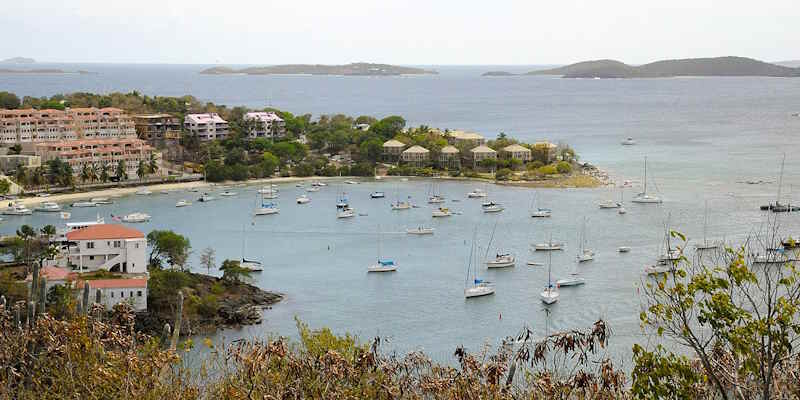
Getting to St. John requires boarding a ferry from the main port in Charlotte Amalie, St. Thomas, or Red Hook Bay. The ferry ride from Charlotte Amalie port to St. John takes 45 minutes, and from Red Hook pier is 20 minutes. Occasionally, cruise ships arrive at St. John and tender in Cruz Bay.
Getting to St. John Beaches From Cruz Bay
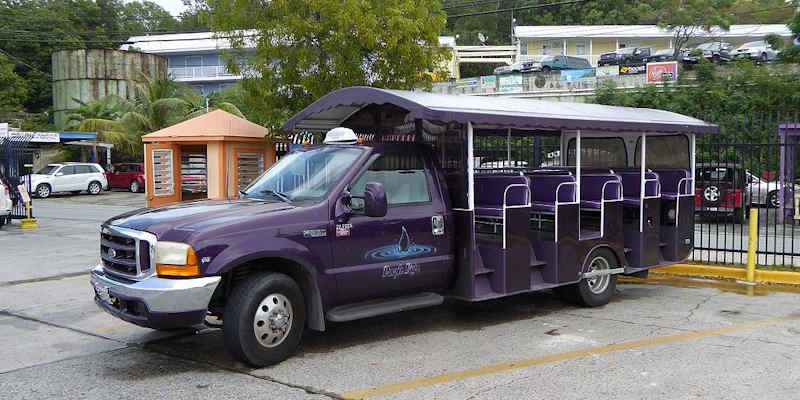
A car or taxi is the primary way to get to the beaches in St. John from Cruz Bay. Once you arrive in Cruz Bay, you can easily rent a car or hire a taxi to take you to your desired beach destination. Taxis operate along the island’s north shore and can carry between eight and 12 people. Just remember to confirm the fare before your journey.
A bus runs between Cruz Bay and Coral Bay along Centerline Road; however, the service is cruise-dependent, so check departure times before waiting for the bus. Buses also run to Salt Pond, a distance of 12 miles (19 km).
Hiring a car is a viable option if you spend more than a day in St. John. However, parking can be tight at the most popular spots, and you must remember to drive on the left.
Map of St. John Beaches
The Best Beaches on St. John (North Shore Beaches)
The north shore of St. John is home to some of the most breathtaking and pristine beaches in the US Virgin Islands. From secluded coves to well-known stretches of white sand, beaches on the island’s north coast offer something for every traveler.
Trunk Bay Beach
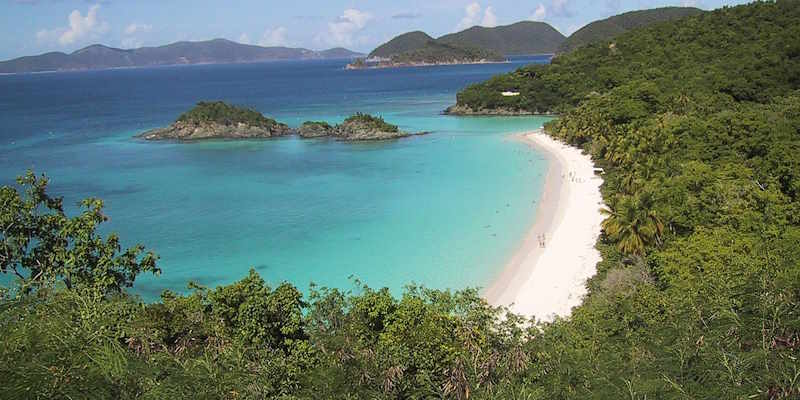
Trunk Bay Beach is frequently listed first in the list of “Best Beaches in St. John.” It’s famous for its stunning white sand, crystal-clear turquoise waters, and vibrant coral reefs. The spacious beach, with its powdery white sand and shallow waters, is surrounded by lush tropical vegetation. It provides plenty of room for relaxation and sunbathing.
Snorkeling at Trunk Bay is one of the top attractions at the beautiful beach. Thirty yards from the shoreline is a self-guided underwater snorkeling trail at Trunk Cay. Plaques identify coral formations and marine life here, making it perfect for snorkeling enthusiasts.
Trunk Bay is part of the Virgin Islands National Park, ensuring its natural beauty is preserved.
Swimming and sunbathing are also popular activities at Trunk Bay Beach. The beach can get crowded near the beach entrances. However, you can walk along the sandy shore to find quieter, more secluded places under swaying coconut palms.
Trunk Bay Beach is one of the safest beaches on St. John. Although you must pay an entrance fee to the beach, it has a lifeguard on duty, and the waters close to the shore are shallow. You will also find restrooms, showers, snorkel gear rental, and a snack bar and grill.
- Distance from Cruz Bay: 3.6 miles (5.8 km)
- Facilities: Restrooms, showers, snack bar, lifeguards, parking
- Atmosphere: Vibrant and family-friendly, often bustling with visitors on cruise days
- What the beach is best for: Snorkeling, swimming, and sunbathing
Maho Bay Beach
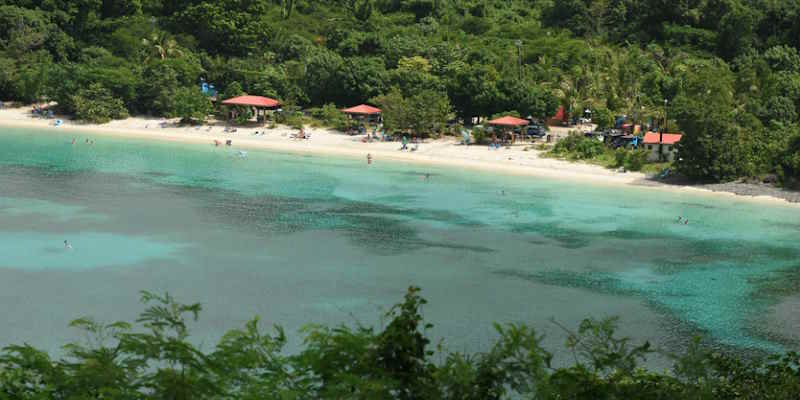
The beach at Maho Bay is one of the most popular, family-friendly beaches in St. John. Its pristine white sands, turquoise waters, and lush vegetation lining the shore offer a picturesque setting. Its calm waters and protected bay make it perfect for families with small children.
The appeal of Maho Bay Beach for families is its gentle slope into shallow waters. Although it lacks a lifeguard on duty, the beach is relatively safe for kids to swim and splash around. However, being one of the most popular beaches on St. John, it can become crowded during peak season and school holidays.
A highlight of Maho Bay Beach is the opportunity to spot sea turtles just off the shore. The bay has a large seagrass meadow that attracts turtles and other marine life. Snorkeling in the clear waters allows you to marvel at these magnificent sea creatures.
If you enjoy walking, you can hike the steep, rugged trail up American Hill to the Great House Ruins. From this vantage point, you will have superb views of Maho Bay, Francis Bay, and Tortola in the British Virgin Islands.
- Distance from Cruz Bay: 5 miles (8 km)
- Facilities: Restrooms, snorkeling, food trucks, limited parking
- Atmosphere: Family-friendly and relaxed
- What the beach is best for: Family outings
Honeymoon Beach

Honeymoon Beach is one of the most beautiful, secluded beaches on St. John’s north shore. The white sandy shoreline provides a tranquil beach experience as turquoise waters gently lap at the shore. Access to Honeymoon Beach is via a 20-25 minute hike from the Virgin Islands National Park Visitor Center in Cruz Bay.
Once arriving at Honeymoon Beach, you’ll find picture-perfect white sand and crystal-clear waters. The best and most popular activity is to sit back and just enjoy them. However, if you’re one of those beachgoers who seeks action and adventure, you can rent snorkeling equipment, kayaks, and paddleboards from a small stand called the Beach Hut. The lack of crowds at Honeymoon Beach makes it an ideal spot for couples to enjoy a romantic time and relax in the Caribbean sun.
Much of Honeymoon Beach is surrounded by shallow waters, making it great for snorkelers and swimmers to see various marine life such as hard and soft corals, sea turtles, and stingrays. Facilities available include a watersports shack, restrooms, beach chair rentals, and light snacks. Additionally, palm trees and seagrapes provide plenty of shade. The bay is also home to coral reefs, sea turtles, conch, and stingrays.
- Distance from Cruz Bay: 2 miles (3.2 km)
- Facilities: Watersports shack, kayaks, paddleboards, and snacks, restrooms, beach chair rentals
- Atmosphere: Serene, free from noisy tourists
- What the beach is best for: A romantic beach escape
Salomon Bay Beach

Salomon Bay Beach is a hidden gem on St. John’s north shore. It offers soft white sand and azure waters in a secluded and serene environment. Few tourists visit the beach because it is accessible via a scenic one-mile (1.6 km) hike along the Lind Point Trail.
The lack of crowds enhances the peaceful, tranquil atmosphere at Salomon Beach. You can relax and unwind under the palm trees and seagrapes lining the white sandy shore. Popular activities at the secluded beach include snorkeling in the patch reefs and marveling at the diverse tropical fish species and marine life just offshore.
- Distance from Cruz Bay: 1 mile (1.6 km) along a hiking trail
- Facilities: None
- What the beach is best for: Relaxing under palm trees, snorkeling, sunbathing, swimming
Caneel Bay Beach

Caneel Bay Beach Resort was one of the most popular beach locations on St. John’s north shore until hurricanes destroyed it. Due to that, the Caneel Bay Resort was closed to the public, and access to the beach was restricted. Therefore, check ahead if you want to visit the area.
However, it should still be possible to access the beautiful beach and enjoy its soft white sand and crystal-clear blue waters. It’s also an excellent location for snorkeling and exploring seagrass meadows. The bay is also teeming with marine life like turtles, colorful Caribbean fish, and rays. Honeymoon Beach and Salomon Beach offer access to the secluded beach.
Before venturing to Caneel Bay Beach, it’s worth checking the latest online reviews. Reports indicate that some unscrupulous vendors charge exorbitant prices for beach chairs and umbrellas.
- Distance from Cruz Bay: 1.8 miles (3 km)
- Facilities: None, apart from a shuttle bus to Honeymoon Bay Beach
- What the beach is best for: Swimming and sunbathing
Turtle Bay Beach
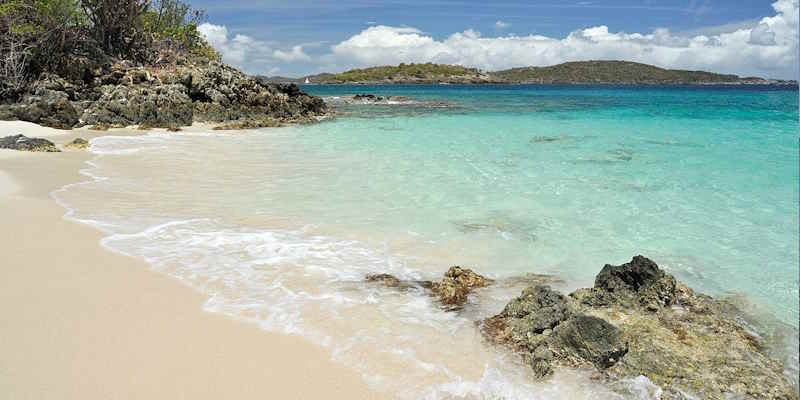
Turtle Bay Beach is a picturesque and secluded stretch of white sand on the island’s north coast. The stunning beach is famous for its clear azure waters, soft white sand, and lush vegetation that provides shade. At the beach, you can relax in an idyllic setting, enjoying stunning views of beautiful islands across Turtle Bay.
The beach at Turtle Bay can be challenging to reach—either by boat, kayak, or hiking through the Caneel Bay Beach resort area. However, this makes the beach less crowded, and you can bask in peace in the Caribbean sun away from the commotion of tourists.
- Distance from Cruz Bay: 1.5 miles (2.4 km)
- Facilities: Limited
- What the beach is best for: Swimming, snorkeling, and quiet relaxation
Hawksnest Bay Beach
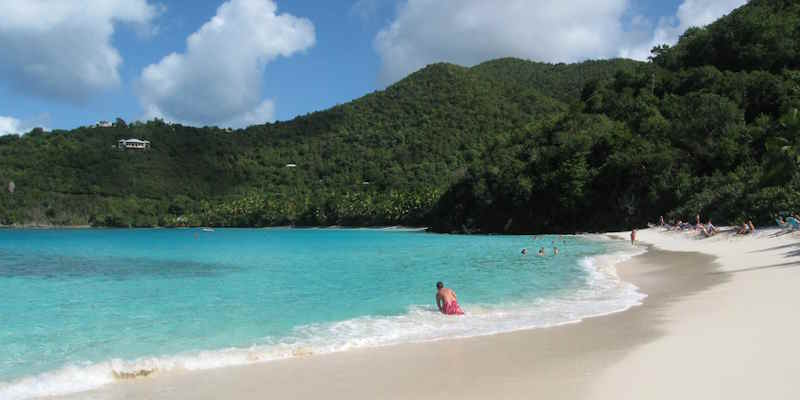
The large beach in Hawksnest Bay is one of the most accessible on the north shore. The stretch of soft white sand features crystal-clear, calm waters and stunning coral reefs close to the shore. The beach can become narrow in certain areas, depending on the tide.
Hawksnest is a favorite beach with families thanks to its shallow waters and easily accessible reefs. Also, there is plenty of parking nearby if you arrive by car. The seagrapes and palm trees lining the sandy shoreline provide a cool retreat from the sun. Due to its location, you can expect gentle surf at the gorgeous beach.
- Distance from Cruz Bay: 2.2 miles (3.5 km)
- Facilities: Restrooms, picnic tables, grills, parking
- Atmosphere: Family-friendly, convenient, and a nice place to watch sunsets
- What the beach is best for: Snorkeling, swimming, and picnicking
Oppenheimer Beach

Oppenheimer Beach—also called Gibney Beach—is a serene and secluded sandy beach spot on the east shore of Hawksnest Bay. The quiet, tranquil beach provides an intimate beach experience because it is rarely crowded. It’s a great place to chill on soft white sands under a palm tree and cool off by swimming or snorkeling in the sea.
Fun fact: Oppenheimer Beach is named after physicist J. Robert Oppenheimer, a key figure in the development of the atomic bomb, who owned property on St. John. His former home is now a community center.
- Distance from Cruz Bay: 2.6 miles (4.2 km)
- Facilities: Apart from limited parking, no facilities
- What the beach is best for: Relaxation, swimming, snorkeling
Mermaid Chair
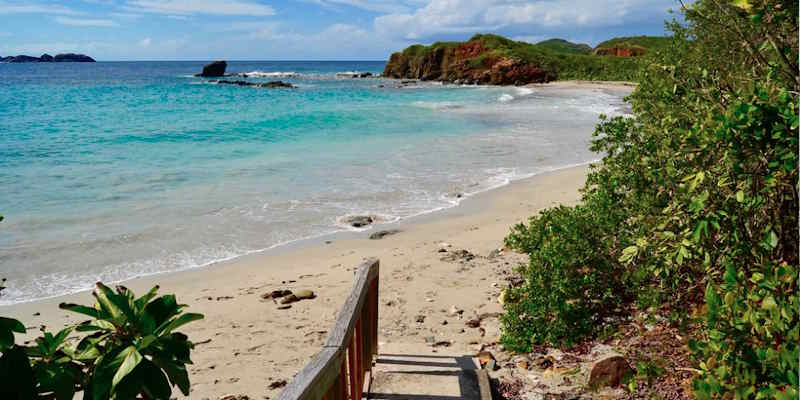
Mermaid Chair is one of the most isolated and difficult-to-reach beaches on St. John. The only way to get to the tiny, secluded beach is by boat, kayak, swimming, or snorkeling from Gibney’s Beach. The beach is a small sandy patch surrounded by imposing cliffs and protected by rocky outcrops.
Perkins Cay in Denis Bay
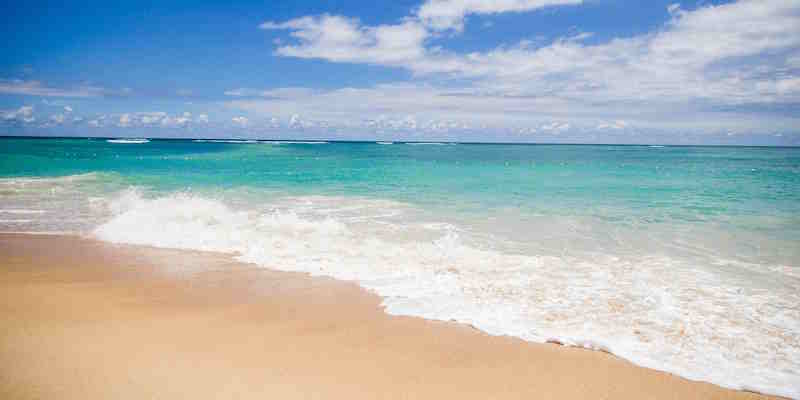
Perkins Cay is a small, secluded beach on St. John’s north shore. This hidden gem features soft sands, rocky outcrops, and clear, calm waters. It’s a picturesque location if you want solitude and to enjoy natural beauty in tropical surroundings. Due to its exposed location, the area is prone to strong currents and winds.
- Distance from Cruz Bay: 3 miles (4.8 km)
- Facilities: None
- What the beach is best for: Relaxation, solitude, and connecting with nature
Jumbie Bay Beach

Jumbie Bay Beach is a short stretch of wind-swept white sand about 100 yards (91 m) long. Despite occasional rough conditions, it offers a beautiful and tranquil spot with turquoise waters and soft white sand. The strong winds mean you often experience strong waves at the beach, and waves batter the reef, making it unsuitable for snorkeling.
One of the attractions of Jumbie Bay Beach is its solitude and tranquil surroundings. The soft sandy shoreline is shaded by lush vegetation, making it ideal for unwinding in the Caribbean sunshine. You get stunning views over the bay from the beach to Trunk Beach.
- Distance from Cruz Bay: 3.1 miles (5 km)
- Facilities: None
- What the beach is best for: Relaxing in solitude on the beach
Cinnamon Bay Beach

The beach at Cinnamon Bay is one of the longest and most popular beaches on St. John. The pristine shoreline is famous for its stunning white sand, clear turquoise waters, and majestic palm trees. The 0.5-mile (0.8 km) beach has shallow water entry and a stunning cay 100 yards (91 m) from the shore.
The sizable shoreline offers plenty of space for sunbathing, beach sports, water sports, and leisurely strolls. Its shallow sea waters make it perfect for families with kids who enjoy swimming. Water sports at the beach include windsurfing, paddleboarding, kayaking, and snorkeling.
The beach offers various amenities, including showers, restrooms, picnic areas, and a snack bar. The nearby Cinnamon Bay plantation ruins add a historical touch to your visit, offering a unique glimpse into the island’s past. There is also a campsite with some amenities if camping in the Caribbean is your thing.
- Distance from Cruz Bay: 4.6 miles (7.4 km)
- Facilities: Restrooms, showers, picnic areas, snack bar, water sports rentals
- Atmosphere: Vibrant, family-friendly vibe
- What the beach is best for: Water sports, snorkeling, family picnic outings, camping, and exploring historical sites
Little Cinnamon Beach
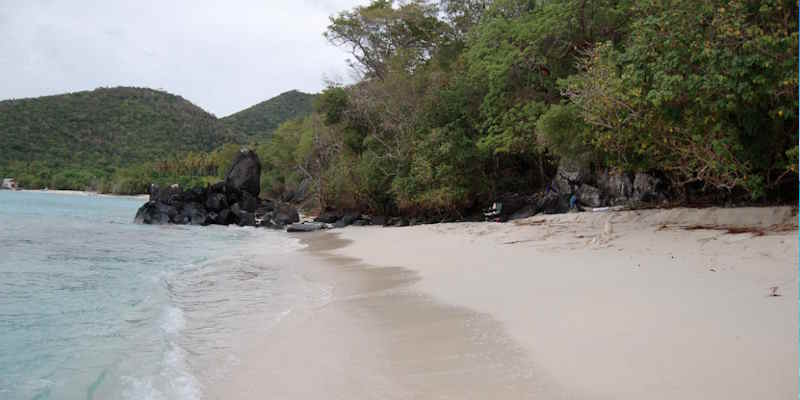
From Cinnamon Beach, stroll along the rocky shoreline to Little Cinnamon Beach. Despite the popularity of Cinnamon Beach, few tourists know about this hidden gem. Here, you can enjoy a secluded beach trip in a peaceful and tranquil setting. Relax on the soft ivory-white sand beach, swim in the crystal-clear waters, and explore a sunken shipwreck 8 ft. (2.4 m) underwater.
There are no formal facilities at Little Cinnamon Beach, so you should come prepared. It’s an ideal beach getaway for solitude and natural beauty without crowds.
- Distance from Cruz Bay: 4.6 miles (7.4 km) and a 200-yard (180 m) hike from Cinnamon Beach
- Facilities: None
- What the beach is best for: Relaxation, swimming, and snorkeling
Francis Bay Beach
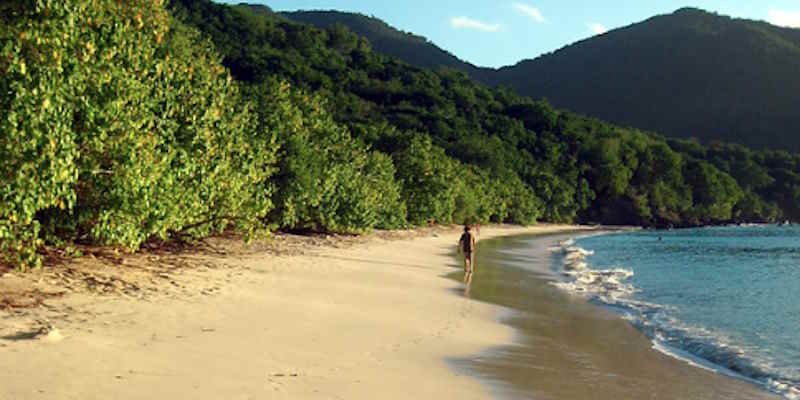
Francis Bay Beach is a tranquil and expansive beach popular with families due to its calm, shallow waters. Located on St. John’s north shore, the long stretch of beach features white sand, clear blue waters, and a serene atmosphere. Plenty of seagrapes and palm trees provide ample shade.
The expansive stretch of soft white sand never gets narrow on high tides. The bay also has an extensive coral reef and seagrass meadow that attracts turtles, giant manta rays, colorful fish, and reef squid.
Bird watchers will also enjoy the nearby salt pond, which attracts many bird species. You can take a 0.6-mile (1.1 km) walk on a boardwalk around the pond to view all sorts of wildlife. It’s possible to explore plantation ruins close to the beach to get a feel for the island’s history.
- Distance from Cruz Bay: 7.8 miles (12.5 km)
- Facilities: Restrooms, picnic tables, limited parking
- What the beach is best for: Swimming, snorkeling, and bird watching
Waterlemon Cay
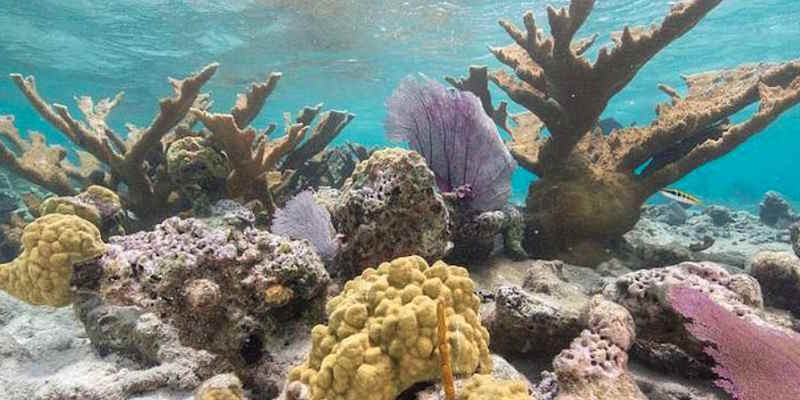
Waterlemon Cay is one of the best snorkeling spots in St. John. Famous for its crystalline seawater and colorful marine life, this small cay offers an unparalleled snorkeling experience. The untouched shoreline features a partially sandy, partially rocky beach amongst picturesque scenery.
To get to Waterlemon Cay, follow the signs for Annaberg Plantation. You then must hike 20 minutes to a sandy beach close to the beautiful cay. The underwater world around the cay features seagrasses, purple sea fans, stunning corals, and various colorful tropical fish.
Beware of strong currents when snorkeling around Waterlemon Cay.
- Distance from Cruz Bay: 7.5 miles (12 km) and a 20-minute hike along the Leinster Bay Trail
- Facilities: None
- What the beach is best for: Snorkeling and nature exploration
Popular St. John Beaches (West Shore Near Cruz Bay)
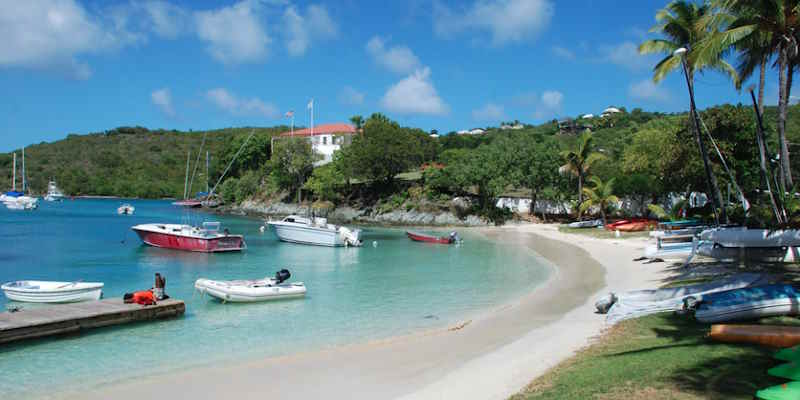
The western shore of St. John is dominated by Cruz Bay, where ferries from St. Thomas arrive. The most popular beach is Cruz Bay Beach, but there are a few more hidden gems on the west shore worth exploring on a vacation or cruise day.
Great Cruz Bay Beach

The Great Cruz Bay Beach is a family-friendly stretch of white sand and crystal-clear, calm waters. The shallow waters are ideal for swimming, and the water trampoline is a hit with kids. Many beach resorts are close if you want to add a touch of luxury to your beach experience.
Great Cruz Bay Beach has many amenities, including beach bars, restaurants, stores, and water sports rentals. The palm tree-lined beach always has a lively atmosphere and is popular with locals. Its proximity to Cruz Bay town makes it suitable to spend an entire day at the beach.
Boat trips are also available for snorkeling tours or deep-sea fishing.
- Distance from Cruz Bay: 1.2 miles (1.9 km)
- Facilities: Restaurants, bars, beach chairs, umbrellas, water sports rentals
- Atmosphere: Lively with convenient access to downtown Cruz Bay
- What the beach is best for: Swimming, dining, and water sports
Hart Bay Beach

The beach at Hart Bay is a hidden gem on St. John’s southwestern shore. The narrow strip of pristine sandy beach is known for its rugged beauty and lush vegetation hugging the shoreline. The rocky shoreline features pockets of soft sand and crystal-clear waters. Its isolated location means it is usually deserted—an ideal spot for a serene beach experience.
Hart Bay has spectacular snorkeling opportunities due to its rocky nature and large reef in the middle of the bay. Here, you can explore diverse marine life and coral formations. Some of the amazing fish you can see include surgeonfish, parrotfish, Spanish hogfish, snappers, and butterflyfish.
Access is via a short, somewhat challenging hike. A lack of facilities means you must bring your own snorkeling gear, snacks, and drinks. However, this adds to the sense of adventure and isolation.
- Distance from Cruz Bay: 2.2 miles (3.5 km)
- Facilities: None
- What the beach is best for: Snorkeling and solitude
Frank Bay Beach
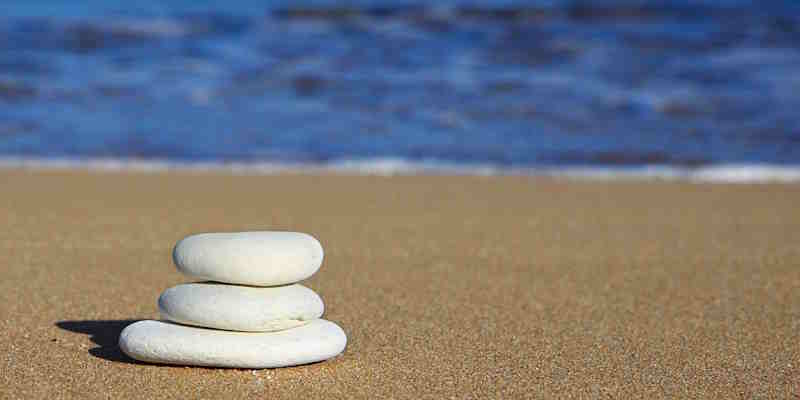
Frank Bay Beach is an unspoiled beach within walking distance of the Cruz Bay ferry terminal. The shore features a blend of sand and smooth stones, with clear, calm waters, ideal for swimming. Despite being close to the town, it’s largely forgotten, making it relatively secluded, even when many tourists are on the island.
The beach is a narrow strip of white sand and pebbles. At high tide, the beach becomes even narrower. Also, there are few spots with shade, except for the solitary coconut palm located at the beach’s eastern end. Note that the shoreline has a pebbly bottom, so take care when entering the warm waters.
- Distance from Cruz Bay: 0.4 miles (0.6 km), or a 10-minute walk
- Facilities: Amenities are available in Cruz Bay
- What the beach is best for: Swimming and sunset views
Beautiful Beaches on St. John (South Shore)
Many beaches on the southern coast of St. John have rugged beauty and are usually only accessible by hiking trails. Apart from Salt Pond Bay Beach—the most popular snorkeling destination—most beaches are a mixture of soft white sand and smooth pebbles.
Salt Pond Bay Beach
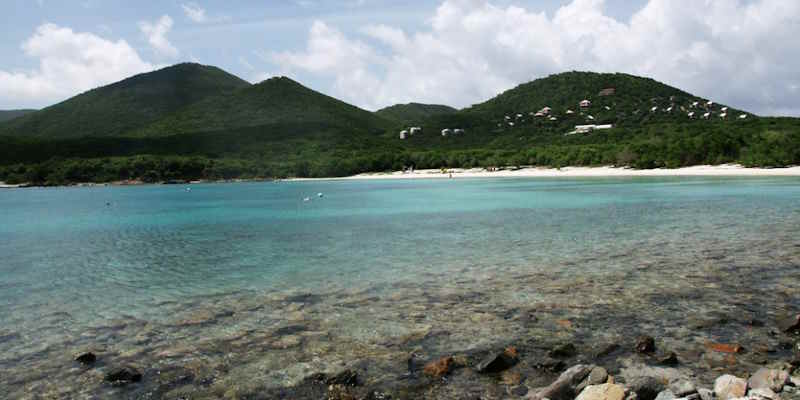
Salt Pond Bay Beach is a serene and scenic spot with pristine white sands in a protected bay. The large beach on St. John’s southeastern coast is known for its calm, clear waters, and beautiful surroundings. The beach is also a starting point for several hiking trails, adding to its appeal.
Salt Pond Bay Beach is a top snorkeling destination in St. John. The bay is home to several coral reefs and a large seagrass meadow. Close to the shore, you can explore stunning coral reefs and observe beautiful tropical fish species up close.
The nearby salt pond attracts various bird species, making it an excellent spot for bird watching. You can also take the Drunk Bay Trail to explore the rugged coastline of Drunk Bay. Or you can take the Ram Head Trail to the isolated Blue Cobblestone Beach.
Salt Pond Bay Beach is accessible via a short hike from the parking area, and basic facilities are available.
- Distance from Cruz Bay: 12 miles (19 km)
- Facilities: None
- What the beach is best for: Snorkeling, hiking, picnics, and bird watching
Lameshur Bay Beach

Lameshur Bay Beach is a peaceful, remote stretch of shoreline in a large, protected bay with a mix of fine sand and smooth pebbles. The crystalline waters are perfect for snorkeling and swimming. Also, the large seagrass meadow in the bay means you’ve excellent chances of seeing sea turtles and rays. Its seclusion makes it a tranquil retreat away from the crowds.
Lameshur Beach has plenty of parking available. You’ll find basic facilities, like portable restrooms, picnic tables, and barbecue grills. Additionally, several hiking trails start from Lameshur Bay, offering scenic views on the way to Europa Bay or the historic ruins of a plantation house or sugar mill.
The beach at the nearby Great Lameshur Bay mainly consists of pebbles and has minimal sand, making it less ideal for typical beach activities.
- Distance from Cruz Bay: 13.6 miles (22 km)
- Facilities: Picnic tables, BBQ grills, restrooms, parking
- What the beach is best for: Snorkeling, swimming, hiking, and diving
Reef Bay Beach
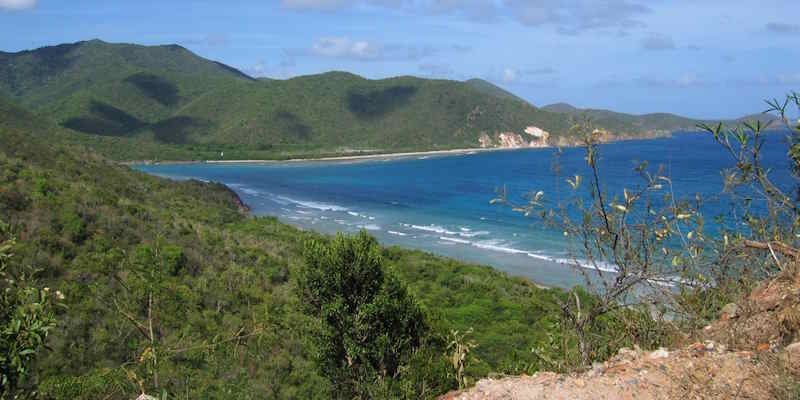
Reef Bay Beach is an isolated 2-mile (3.2 km) stretch of soft white sand in a serene environment. It is famous for its historical plantation ruins, a disused sugar mill, hiking trails through mangroves, and ancient petroglyphs. There is also good access to the water for snorkeling.
Access to the secluded beach is only on foot or by boat.
- Distance from Cruz Bay: 4.2 miles (6.7 km)
- Facilities: None
- What the beach is best for: Exploring historical sites, hiking, snorkeling
Grootpan Bay
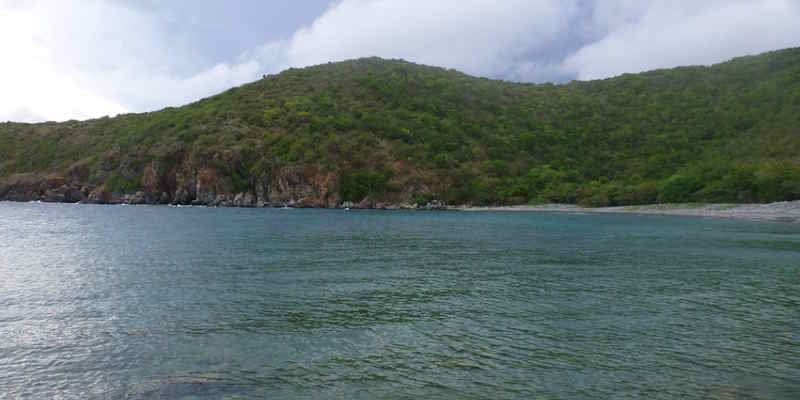
Grootpan Bay Beach is a hidden gem known for its rugged beauty and peaceful atmosphere on St. John’s southern coast. The beach features a combination of sand and pebbles, with crystal-clear waters and stunning views. Its remote location ensures a quiet and undisturbed beach experience.
- Distance from Cruz Bay: 12.7 miles (20.4 km)
- Facilities: None
- What the beach is best for: Relaxing in a serene atmosphere, snorkeling, beachcombing
Friis Bay Beach
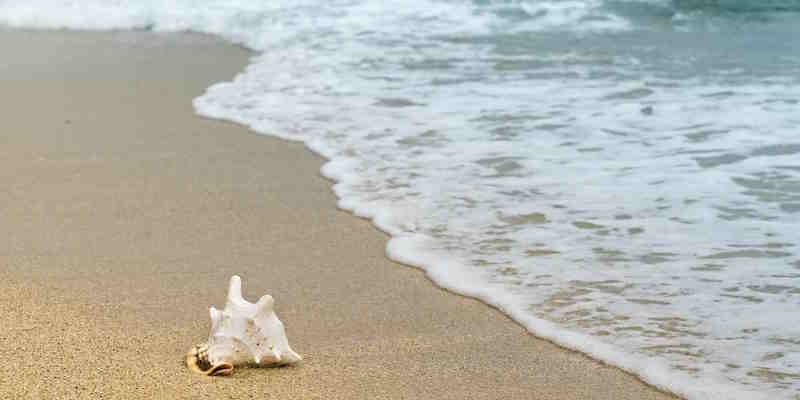
Friis Bay Beach is a secluded and serene spot on St. John’s southeastern coast. The beach is only accessible by boat as access to the beach by land is restricted. The sandy beach is in a small bowl-shaped bay and offers a quiet atmosphere to relax, unwind, and snorkel in crystal-clear waters.
Local dining options are also available near the beach.
- Distance from Cruz Bay: 10.7 miles (17.2 km)
- Facilities: Nearby restaurants
- What the beach is best for: Swimming and relaxation
Stunning Secluded St. John Beaches (East Shore)
St. John’s eastern shore features diverse beaches, each offering unique experiences. You will find sandy shores with secluded, rugged beaches, tranquil bays and raw beauty. Whether exploring hidden coves, snorkeling in coral reefs, or relaxing on soft white sand, the eastern beaches provide a tranquil escape from the busier northern beaches.
Haulover Bay Beaches
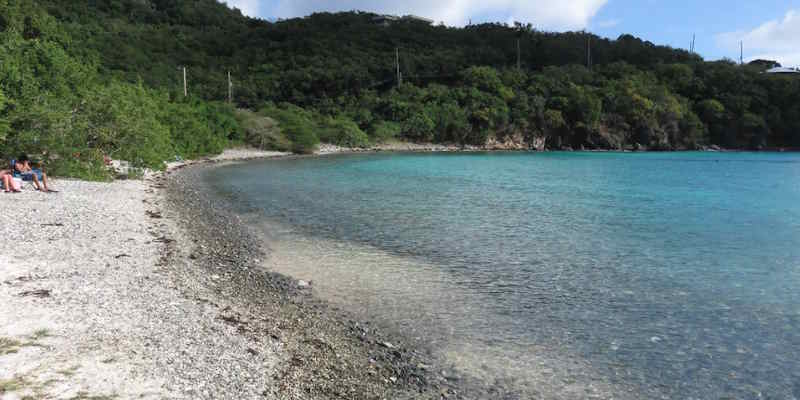
Haulover Bay has two types of beaches—a white sand beach on the southern side and a pebbly beach on the northern side. Both beaches are separated by a 163-yard (150 m) trail.
Haulover Bay South is a popular beach for relaxing in the Caribbean sun away from crowds of tourists. The crescent-shaped beach has soft white sand and crystal-clear azure waters. Seagrapes provide plenty of shade along the shoreline.
Haulover Bay North Beach is the better of the two for snorkeling. Corals and sea fans grow almost to the water’s edge, and the best corals and marine life are in five to 20 feet (1.5 to 6 m) of water. Because of the strong waves and surf, it is best to explore the deeper parts to avoid injuring yourself on the jagged coral in shallow waters.
- Distance from Cruz Bay: 11.6 miles (18.6 km)
- Facilities: None
- What the beach is best for: Snorkeling
Limetree Cove Beach
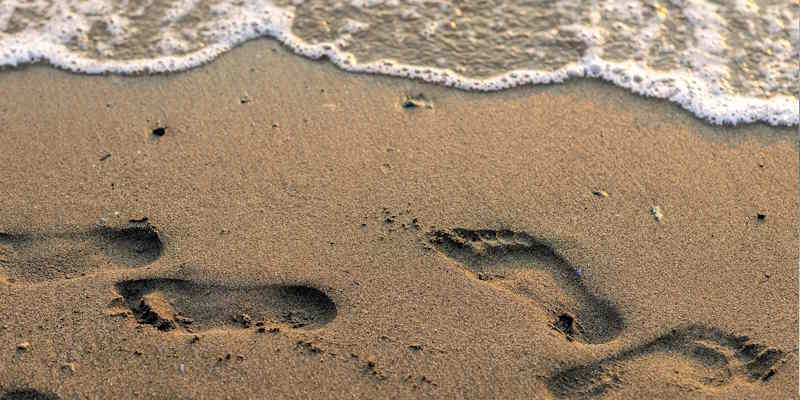
One of the most secluded beaches on St. John’s eastern shore is Limetree Cove. This tiny sand and pebble beach is only accessible by boat, paddleboard, or kayak from Hansen Bay. Entry to the water is on a smooth, sandy bottom, making it ideal for swimming. There is also good snorkeling close to the shore.
- Distance from Cruz Bay: 11.6 miles (18.6 km)
- Facilities: None
- What the beach is best for: Relaxing in peace and tranquility
Hansen Bay Beach
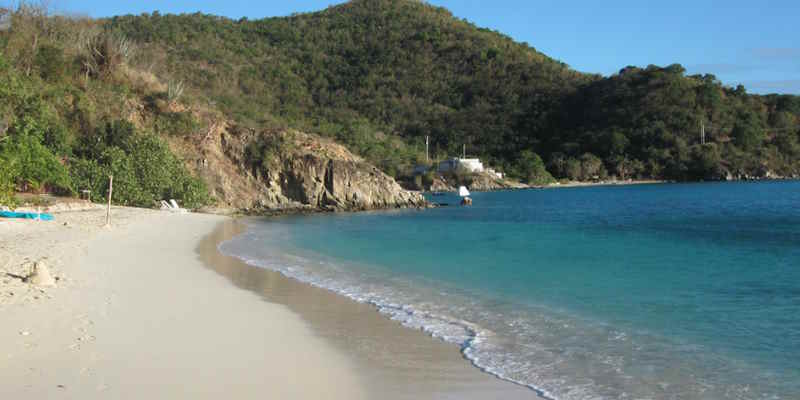
Hansen Bay Beach is a crescent-shaped beach with soft white sand. The stunning bay is protected from strong sea currents, swells, and waves, making it perfect for swimming. The beautiful beach is surrounded by lush greenery, providing a tranquil setting and plenty of shade for a peaceful day on the beach.
Many snorkeling enthusiasts vote Hansen Bay as a top spot on St. John. The bay is home to spectacular rocky patch reefs and seagrass. Also, you can swim out to Pelican Rock to explore stunning coral structures.
- Distance from Cruz Bay: 12 miles (19.3 km)
- Facilities: Beach rentals, picnic tables, and watersports rentals
- What the beach is best for: Snorkeling, swimming, and beach relaxation
Whitesands Bay Beach
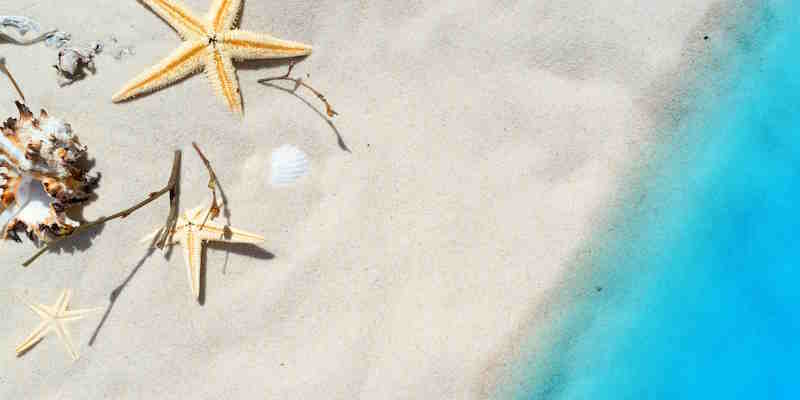
Whitesands Bay Beach is a hidden beach on St. John’s eastern shore that is worth the effort to get to. It’s a pristine, tranquil beach renowned for its soft white sand and crystal-clear waters. The only access to the beach is by kayak or paddleboard from East End Road or Coral Bay.
You’ll likely enjoy the serene and picturesque setting on your own as few tourists visit the secluded spot. The bay has large seagrass meadows and is home to starfish and juvenile queen conch. You can also kayak through the mangroves at Hurricane Hole, Water Creek, or Otter Creek.
- Distance from Cruz Bay: 9.5 miles (15.2 km)
- Facilities: None
- What the beach is best for: Swimming, snorkeling, kayaking, and paddleboarding
Brown Bay Beach
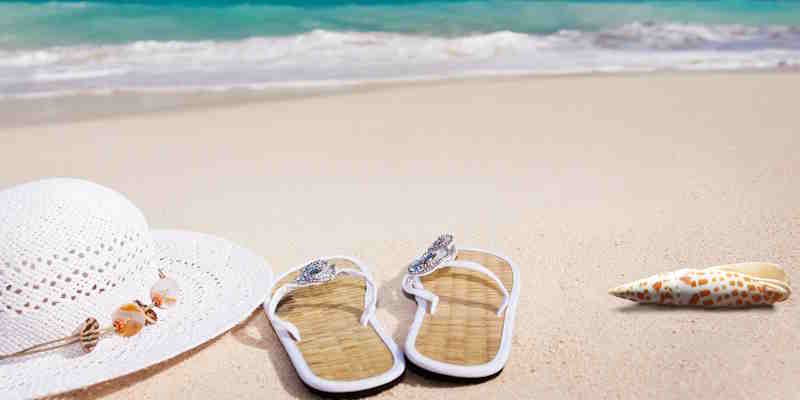
Brown Bay Beach is one of the best off-the-beaten-path beaches on St. John. The stunning beach is a stretch of fine white sand with a pebbly shoreline. Shallow entry to the waters on a sandy bottom and gentle waves make swimming and snorkeling a dream.
Access to the beach at Brown Bay is by a 30-minute hike along the Brown Bay Trail. On the way, you can explore the Hermitage Ruins. Its remote location ensures a quiet and intimate experience away from crowds.
- Distance from Cruz Bay: 9.3 miles (15 km) plus a 30-minute hike
- Facilities: None
- What the beach is best for: Snorkeling, swimming, and relaxing with views of the Caribbean and Frenchman’s Cay in the British Virgin Islands
Mennebeck Bay Beach

Hugging St. John’s rugged eastern coastline is a small stretch of white sand called Mennebeck Beach. This dramatic beach is a hidden getaway with rocky outcrops, clear waters, and an untouched natural beauty. However, entry to the water is relatively deep, and strong waves and currents make swimming and snorkeling challenging.
Mennebeck Bay Beach is one of the most difficult beaches on St. John to access.
- Distance from Cruz Bay: 10.7 miles (17.2 km)
- Facilities: None
- Atmosphere: Wild and rugged
- What the beach is best for: Snorkeling if you’re a strong swimmer, but only on the calmest of days
St. John Beaches: FAQs

Do you have to pay to go to the beaches in St. John?
All beaches in St. John are accessible to the public and free of charge. However, you may have to pay a nominal fee for amenities like parking, beach rentals, or other beach facilities.
Trunk Beach is the only beach on St. John where you must pay an entrance fee to access the beach.
What currency should I use in St. John?
The official currency in St. John is the US dollar (USD). Therefore, there’s no need to exchange money if you already have dollars, as all stores, vendors, and tour operators accept them.
What should I pack for a beach day in St. John?
Pack sunscreen to protect yourself on a beach day on St. John, as well as plenty of water, snacks, a hat, sunglasses, a beach towel, and snorkeling gear. Take a beach umbrella or tent for shade if possible, as not all beaches have shaded spots. Don’t forget a bag for your trash to help keep the beaches clean.
How can I stay safe on the beach?
To stay safe on the beach, always swim in designated areas and be aware of current weather and sea conditions. Some beaches on the eastern and southern shores have strong currents, and you must exercise caution when swimming. Never go snorkeling alone. Also, pay attention to any posted warnings or advice from locals about strong currents or marine life.
What are the best beaches for turtles on St. John?

Maho Bay Beach and the nearby Francis Bay Beach are the best places on the island for spotting sea turtles. Francis Bay has extensive seagrass beds where turtles frequently graze, offering excellent opportunities for turtle watching.
Do St. John beaches have lifeguards?
The only beach on St. John’s Island with lifeguards is Trunk Bay. Therefore, always exercise caution when swimming at beaches without lifeguards and be mindful of the ocean conditions.
When is the best time to visit St. John beaches?
The best time to visit St. John beaches is during the dry season, from December to April. This time of year offers the most pleasant weather with less rain and lower humidity. However, it is also the peak tourist season, so beaches may be busier.
Are beaches in St. John pet-friendly?
Cruz Bay and Hansen Bay Beach are two of the few public beaches in St. John where dogs are allowed. Many St. John beaches are in the Virgin Islands National Park, which has restrictions on pets. According to the National Parks Service, leashed dogs are permitted on trails but not on beaches.
Related articles:
